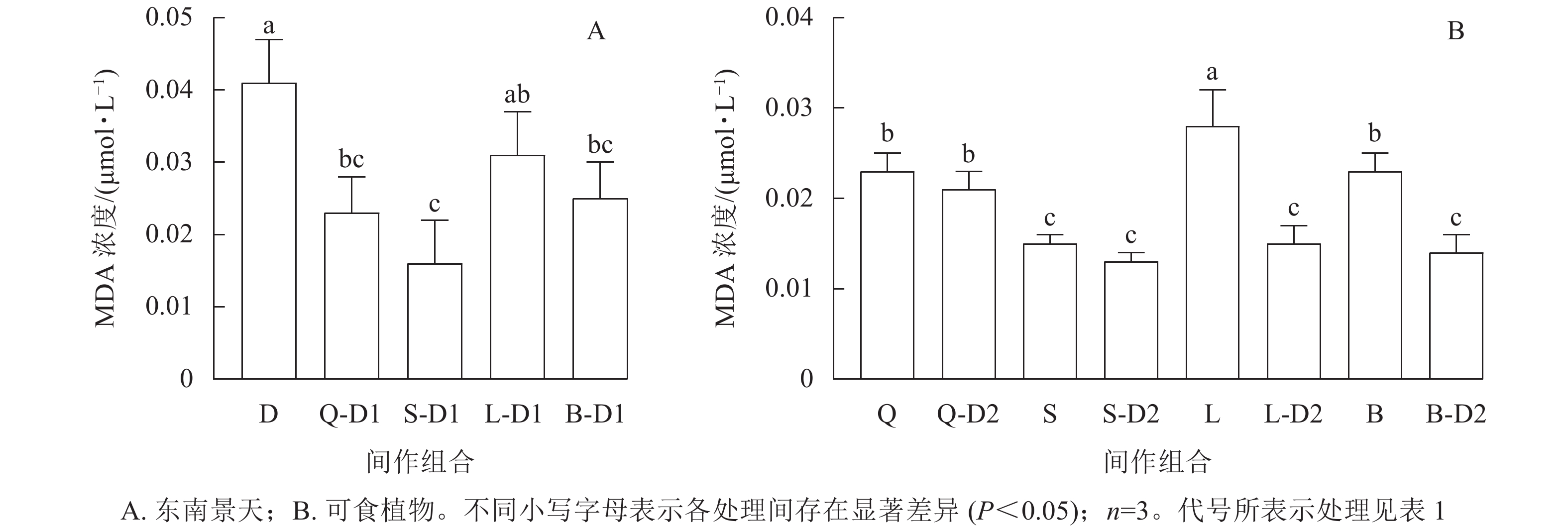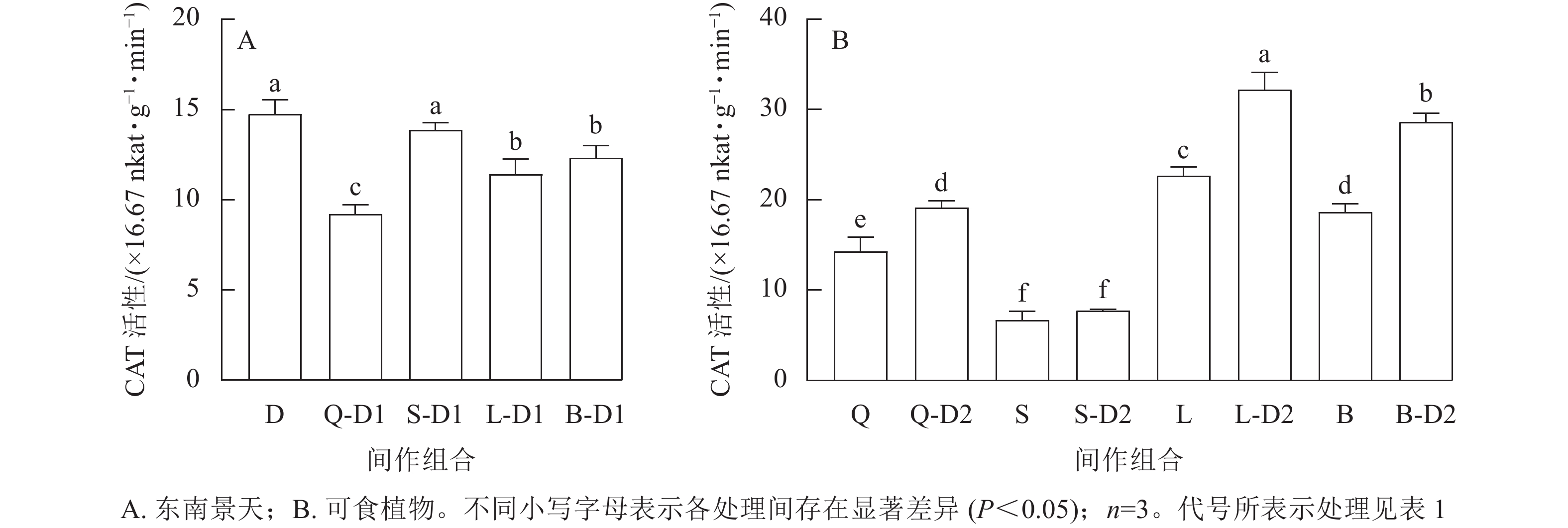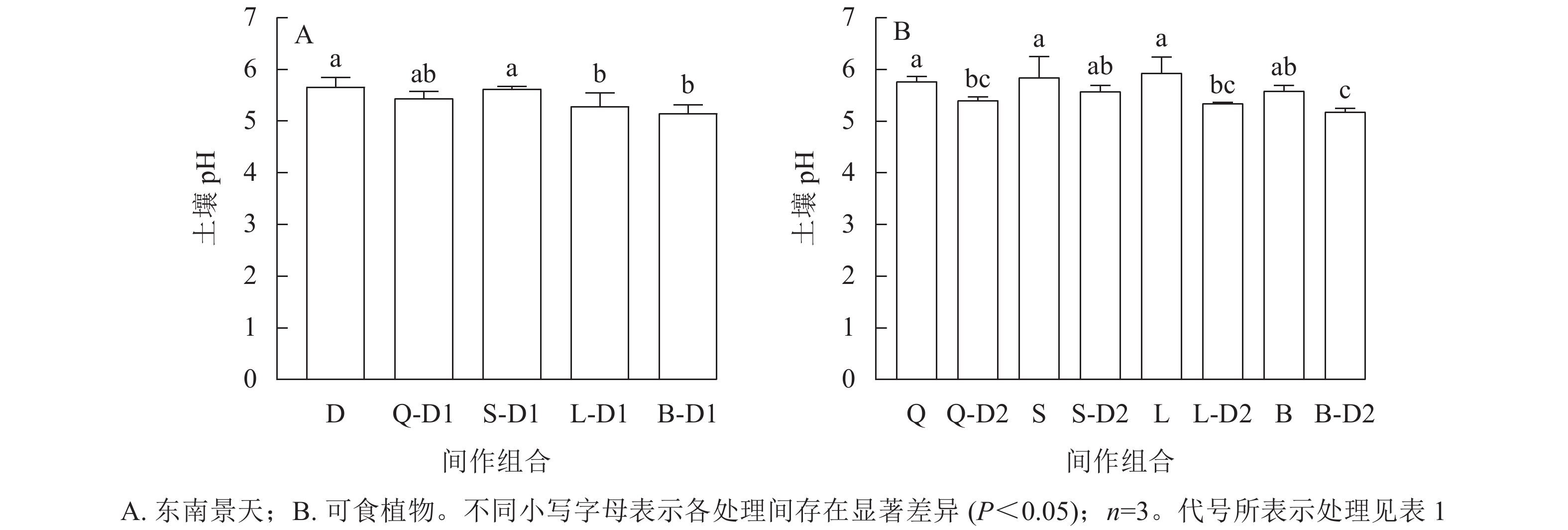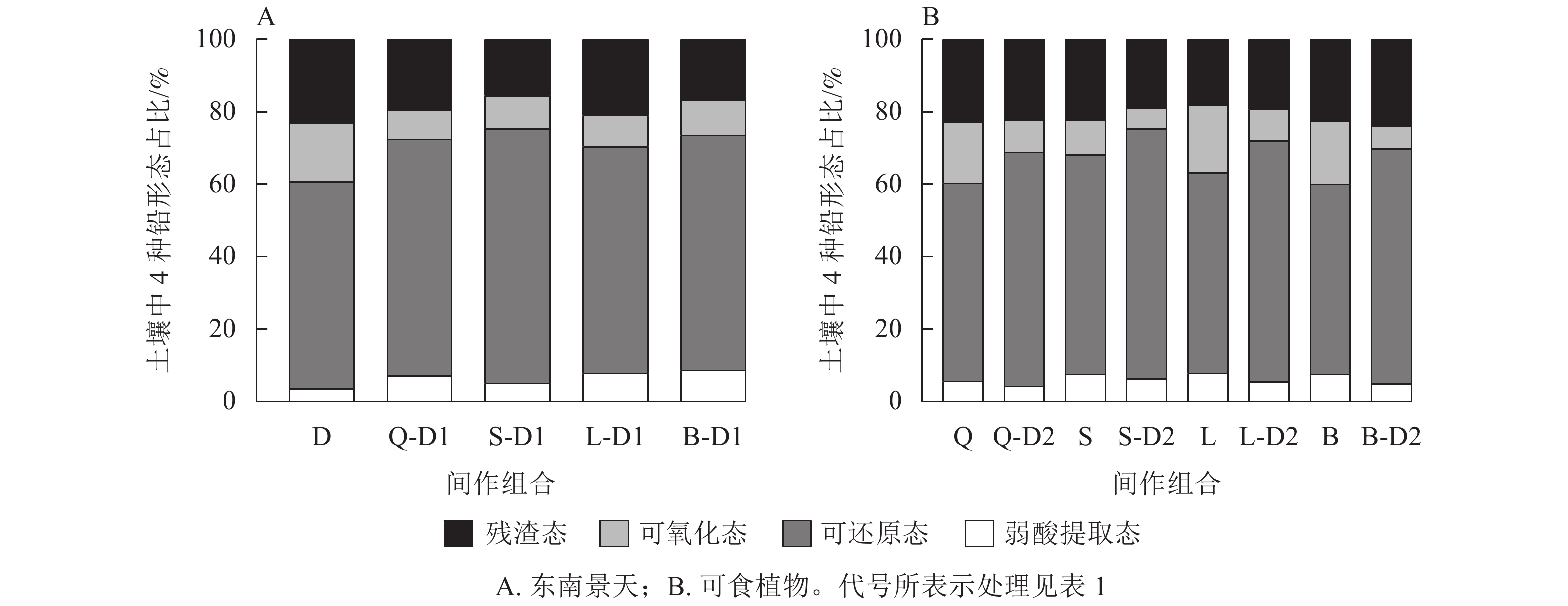-
社区花园(community gardens)是指居民在社区碎片绿地内共同建造维护、种植花果蔬菜等的场地[1],是都市农业在社区应用中的主要形式之一,因其具有生态、社会和经济效益而广受人们欢迎[2]。在社区花园内以种植果蔬为目的的园艺活动能促进居民之间的交流与互动,满足人们在农耕习俗等中国传统文化中产生的对自然和田园生活的需求与向往[3]。作为能够提供公众参与园艺活动和种植食用植物的场所,土壤环境质量和植物的生长状况对社区花园健康建设具有重大的影响。重金属是土壤环境的主要污染物之一。受长期施肥[4]、生活垃圾[5]和交通运输[6]等人为活动的影响,社区花园土壤中重金属铅无处不在,对健康园艺实践产生一定的阻碍。近年来,国外学者对社区花园土壤中重金属铅污染进行了检测和评估[7],发现社区花园土壤中的重金属会在可食植物中积累,对人体产生健康风险[8]。MITCHELL等[9]对纽约市社区花园中的564个土壤样本进行重金属分析发现:土壤中铅含量超出标准值。国内社区花园研究处于起步阶段,对社区花园土壤重金属污染研究较少。杨剑洲等[10]在对与社区花园功能相似的种植园农作物调查时发现:土壤中的铅可在蔬果中积累,超标率达2.67%。土壤作为社区花园植物生长最基本的载体,一方面铅的累积势必会影响植物各项生理指标,造成社区花园内可食植物产量、质量的降低以及土壤性质的恶化[11];另一方面铅会在可食植物中积累进入食物链危害人类健康,增加患病概率[12],其可能引发的潜在危害已成为城市社区花园土壤污染亟待解决的问题之一。
目前,以植物修复为代表的生物修复被认为是最经济、安全且可持续的土壤重金属修复方法[13]。超富集植物是植物修复技术的核心。东南景天Sedum alfredii因其环境适应性强,生长速度较快成为重金属铅污染下的理想植物修复材料[14]。近年来,利用超富集植物去除土壤重金属的研究取得许多成果,但大多局限于工业区、矿区或农田等场地,极少关注城市社区花园土壤重金属污染修复问题,且间作对铅污染下植物生理特性变化及重金属吸收研究较少,修复策略还不具备较强的针对性和实践性。本研究通过盆栽试验,探究社区花园土壤铅污染下的4种可食植物(上海青Brassica chinensis、樱桃萝卜Raphanus sativus、辣椒Capsicum annuum、青芹Apium graveolens)在单作及与东南景天间作2种种植模式下的生理特性以及对重金属铅的吸收特征,以期筛选出降低可食植物对铅吸收的最佳种植模式,打造集生态可持续性和景观多元为一体的社区花园,促进社区生态与景观协同发展。
-
本研究供试土壤采自绍兴市上虞区小担山苗圃区,取样深度为0~20 cm。供试土壤自然风干后,小部分土壤过10目筛,测定土壤基本理化性质和重金属铅质量分数。经测定,土壤pH 6.22,速效钾为7.40 mg·kg−1,有机质为2.13 g·kg−1,碱解氮为118.50 mg·kg−1,有效磷为2.43 mg·kg−1,铅为258.64 mg·kg−1。参照GB 15618—2018《土壤环境质量 农用地土壤污染风险管控标准》土壤铅筛选值,苗圃区铅质量分数超过约2.8倍,并且高于《浙江省土壤地球化学背景值》中规定铅元素环境背景值8.5倍。其余土壤过5 mm筛,清除植物残体和石块,磨碎,用于盆栽试验。
-
超富集植物东南景天采自浙江省杭州市临安区平山温室。选取长势良好且大小一致的东南景天,截取5 cm枝条,移至温室在营养土中培育2周至长出根系,选长势良好的苗备用。选择辣椒、上海青、樱桃萝卜、青芹为可食植物。以上4种可食植物为本地居民常见种植,且在人们的日常饮食中不可或缺。
-
盆栽试验于2021年9月11日在浙江省临安区浙江农林大学平山苗圃(30°25′N,119°72′E)进行。培养盆上、下口径分别为29.5、17.5 cm,高19.7 cm。每盆放置6 kg污染土并浇水,稳定7 d后播种,同时挑选长势相同、生长健壮的东南景天幼苗移栽。待可食植物长出3~4片真叶后进行间苗定植,株距为10 cm。每盆按十字划分,以呈对角方式种植4株,且间作使同种植物保持在对角线上。植物单作为对照组,间作东南景天为处理组,共设2种种植模式,每组处理3次重复,共计27盆(表1),随机分布,培养120 d。试验期间定期浇水,土壤水分维持在田间持水量的70%,光照条件为自然光,观察其生长状况。
种植模式 处理 代号 种植模式 处理 代号 单作 青芹 Q 间作 东南景天-上海青(东南景天) S-D1 单作 上海青 S 间作 东南景天-上海青(上海青) S-D2 单作 辣椒 L 间作 东南景天-辣椒(东南景天) L-D1 单作 樱桃萝卜 B 间作 东南景天-辣椒(辣椒) L-D2 单作 东南景天 D 间作 东南景天-樱桃萝卜(东南景天) B-D1 间作 东南景天-青芹(东南景天) Q-D1 间作 东南景天-樱桃萝卜(樱桃萝卜) B-D2 间作 东南景天-青芹(青芹) Q-D2 说明:间作模式各处理括号中列出的是该模式下的采样植物 Table 1. Pot experiment design
-
可食植物和东南景天同期收获取样,用尺子测量每株植物的株高和根长,并将植物分解成根、茎、叶3个部分。将根系浸泡于20 mmol·L−1乙二胺四乙酸二钠(EDTANa2)中20 min,以去除根系表面吸附的重金属,随后用去离子水反复冲洗3次,吸干植物表面水分后分成根、茎、叶、果4个部分,装入牛皮纸信封袋内,分别取样测定鲜质量;再于105 ℃下杀青0.5 h,随后在70 ℃下烘干至恒量,测定干质量并粉碎,分别过100目备用于重金属指标测定。取盆栽中土壤混合样约1 kg左右,清除植物碎片带回实验室自然风干,将干燥的土样经研磨后分别过10和100目尼龙筛,置于样品袋中备用。
-
采用硫代巴比妥酸法测定丙二醛(MDA)浓度[15],采用紫外分光光度法测定过氧化氢酶(CAT)活性。采用HNO3-HClO4混合酸法消解植物样品中的铅,在消煮植物样品过程中采取平行样和GSB标准植物样进行分析质量控制,同时做空白实验;采用HNO3-HF-HClO4三酸法消解,测定土壤铅全量,在消煮过程中采用平行样和GSS标准土样进行质量控制,同时做空白实验。采用pH计在1.0∶2.5土水质量比下测定土壤pH。采用BCR三步萃取法[16] 分析土壤铅形态,分别提取弱酸提取态铅、可还原态铅、可氧化态铅和残渣态铅。每组试验均重复3次,采用石墨炉原子吸收光谱法(GFAAS,PerkinemerAA800,美国)检测样品上层清液中铅质量分数。
-
采用Excel 2010和SPSS V22.0统计软件进行数据统计与方差分析,Duncan新复极差法进行差异显著性分析(P<0.05),用GraphPad Prism 9作图。富集系数(FBC)=植物器官中铅质量分数/土壤中铅质量分数;转移系数(FT)=植物地上部铅质量分数/植物地下部铅质量分数。
-
如图1所示:与单作相比,间作模式均显著增加东南景天地上部生物量(P<0.05),根部生物量均有不同程度增加,但无显著差异(图1A)。东南景天与樱桃萝卜间作相较于其他3种模式中地上部和根部生物量增幅最大,分别达120.97%、184.78%。与可食植物单作相比,间作促进青芹、辣椒地上部和根部生物量的积累(图1B),分别增加了34.47%、52.49%和63.58%、59.86%;其中间作模式下青芹总生物量增幅最大,辣椒增幅最小。上海青地上部生物量显著降低42.05% (P<0.05),根部生物量降低32.05%,但无显著差异;樱桃萝卜地上部生物量降幅达65.10%,根部生物量由16.94 g·株−1降低到11.77 g·株−1,存在显著差异(P<0.05)。
-
由图2可知:东南景天和可食植物在不同处理模式下丙二醛浓度表现出较为一致的规律,间作均低于单作。对比东南景天和可食植物在间作下丙二醛浓度的变化,发现东南景天叶片中丙二醛浓度比可食性植物下降明显,其中与上海青间作降幅最高,达156.25% (图2A)。辣椒在间作中丙二醛浓度降低最多,樱桃萝卜次之,分别较单作下降了47.62%、36.76%;上海青、青芹在间作模式中无显著性差异(图2B)。
-
由图3可知:东南景天在不同间作处理下过氧化氢酶活性均有不同程度的降幅。东南景天与上海青在间作模式中东南景天相比单作降幅为6.40%,但无显著性差异。而东南景天与樱桃萝卜、青芹、辣椒在间作模式下过氧化氢酶活性相比单作分别降低了19.63%、60.07%、29.17%,均存在显著差异(P<0.05) (图3A)。可食植物青芹、辣椒、樱桃萝卜与东南景天间作模式处理中叶片过氧化氢酶活性均存在显著差异(P<0.05),相比单作分别升高了33.92%、41.94%、53.80% (图3B)。
-
如图4所示:东南景天地上部和根部铅质量分数均为间作显著高于单作(P<0.05),且多集中于根部。与樱桃萝卜间作后,东南景天地上部铅质量分数比其他3种植物显著增加了55.00%,与青芹、辣椒间作后,东南景天体内平均铅质量分数较单作分别增加了26.00%和29.00%;与上海青间作时,东南景天铅质量分数均增加,但较单作无显著性差异(图4A)。除上海青外,青芹、辣椒、樱桃萝卜可食部位铅质量分数在间作模式下均有不同程度的降低,分别与单作相比降低24.37%、162.5%、39.82%。其中青芹、辣椒可食部位质量分数分别为0.10和0.08 mg·kg−1,达到GB 2762—2017《食品中污染物限量标准》规定的安全范围。樱桃萝卜可食部位的铅质量分数虽高于标准中的限量值,未达到安全食用范围,但在间作处理下樱桃萝卜中质量分数均低于单作处理,且随着间作时间的延长,间作东南景天有望实现樱桃萝卜的安全生产。间作使上海青体内铅质量分数整体下降,其中根部下降63.79%,但可食部位叶片中铅质量分数较单作增加31.18% (图4B)。根据GB 2762—2017《食品中污染物限量标准》,间作模式下上海青叶片中铅质量分数仍高于标准限量值0.3 mg·kg−1,不可食用。
-
由表2可知:间作提高了东南景天吸收重金属的能力(P<0.05)。与青芹、辣椒、樱桃萝卜间作后东南景天地上部铅富集系数较单作分别上升了3.73%、32.98%、33.37%;与上海青间作后东南景天根部铅富集系数较单作下降24.53%。东南景天与辣椒间作后铅转运系数显著上升了29.87%(P<0.05),与青芹、樱桃萝卜间作后转运系数较单作无显著差异。
植物 处理 FBC FT根—茎叶 根 茎叶 东南景天 D 0.426 76 b 0.098 39 b 0.231 b Q-D1 0.438 03 b 0.102 06 b 0.233 b S-D1 0.331 30 c 0.079 01 c 0.238 b L-D1 0.435 77 b 0.130 85 a 0.300 a B-D1 0.529 70 a 0.131 23 a 0.248 b 说明:表中数据为平均值(n=3)。同列不同字母表示各处理间显著差异(P<0.05)。代号所表示处理见表1 Table 2. FBC and FT of Pb by S. alfredii in different treatments
由于铅在不同可食植物体内转运速度不同,从而导致可食植物体内各部位铅分布出现差异。由表3可知:间作模式减弱可食植物富集铅的能力。青芹各部位在间作模式下铅富集系数较单作均有不同程度的下降,其中在可食部位(茎)中下降显著(P<0.05),降幅达31.79%。在间作模式下上海青根、茎部富集系数有所降低,与单作相比分别降低53.36%、76.86%,但叶中铅富集系数却较单作显著提高了40.10% (P<0.05)。辣椒可食部位(果)铅富集系数相比单作同样呈现显著下降(P<0.05),降幅达133.39%。间作东南景天能使樱桃萝卜可食部位铅富集系数呈显著下降(P<0.05),降幅为18.23%。青芹、辣椒在间作模式下转运系数较单作均有所下降,与单作相比分别下降了33.01%、38.96%。而上海青、樱桃萝卜与东南景天间作后,铅转运系数较单作分别增加了35.85%、6.74%。
植物 处理 FBC FT根—茎叶 根 茎 叶 果 青芹 Q 0.002 24 c 0.001 69 bc 0.000 80 cd − 1.164 b Q-D2 0.002 07 c 0.001 28 c 0.000 50 d − 0.875 c 上海青 S 0.004 07 b 0.002 19 a 0.001 33 b − 0.863 c S-D2 0.002 65 c 0.001 24 c 0.001 86 a − 1.173 b 辣椒 L 0.002 16 c 0.001 57 bc 0.001 11 bc 0.000 96 a 1.688 a L-D2 0.002 34 c 0.001 66 bc 0.000 75 cd 0.000 41 b 1.215 b 樱桃萝卜 B 0.004 79 a 0.002 02 ab 0.000 71 cd − 0.570 d B-D2 0.004 06 b 0.001 65b c 0.000 82 bc − 0.608 d 说明:−表示无此项。数据为平均值(n=3)。同列不同字母表示各处理间具有显著差异(P<0.05)。代号所表示处理见表1 Table 3. FBC and FT of Pb by edible plants in different treatments
-
如图5所示:与东南景天单作相比,青芹、辣椒和樱桃萝卜3种间作模式显著降低东南景天根际土壤pH (P<0.05)。上海青-东南景天间作模式下东南景天根际土壤pH值降低,但没有达到显著水平(图5A)。与可食植物单作相比,间作模式均不同程度的降低青芹、辣椒和樱桃萝卜根际土壤pH,分别降低至5.40、5.34和5.57,差异显著(P<0.05) (图5B)。
如图6所示:在间作模式下,东南景天根际土壤弱酸提取态、可还原态铅质量分数占总铅比例均有不同程度的提升,而可氧化态和残渣态铅的形态占比降低。与单作相比,东南景天与樱桃萝卜在间作模式下,其根际土壤弱酸提取态和可氧化态铅质量分数占总铅比例高于间作上海青和青芹;东南景天根际土壤残渣态铅的形态占比在4种间作模式之间无显著差别(图6A)。可食植物在间作模式下根际土壤可还原态铅的形态占比增大,弱酸提取态和可氧化态铅的形态占比均不同程度降低,残渣态铅则无显著变化。与单作相比,间作处理下樱桃萝卜根际土壤弱酸提取态铅质量分数降低了7.07 mg·kg−1,可氧化态铅质量分数降低了25.79 mg·kg−1;在间作模式下,上海青相较于其他3种可食植物根际土壤可还原态铅质量分数增幅最大,达24.36%,青芹次之,增幅为12.82% (图6B)。
-
间作模式能改变植物生物量。本研究表明:与东南景天间作后,可食植物青芹、辣椒生物量较单作显著增加了65.51%、31.64%,但上海青、樱桃萝卜生物量有所降低。说明东南景天间作上海青、樱桃萝卜后,因盆栽空间的局限造成两者根系养分竞争激烈[17],影响了上海青、樱桃萝卜的生长。青芹、辣椒生物量增加的原因可能是在间作模式下可以加快不同植物共生期间的养分转化,改善土壤的养分状况,提高植物对有效养分的吸收[18]。与单作相比,东南景天生物量显著增加,其原因可能是可食植物为东南景天遮光,缓解了高温带来的不良影响,从而提高东南景天生物量[19]。
丙二醛是膜脂质氧化的产物,是反映植物膜系统受伤害的重要指标之一[20]。本研究结果表明:间作模式下东南景天和可食植物叶片中丙二醛浓度均有不同程度的下降,其中辣椒、樱桃萝卜间作叶片中丙二醛浓度比单作显著下降了47.62%、36.76%。说明间作能缓解铅对植物的毒性。这与王晓维等[21]研究在铜胁迫下玉米Zea mays与豌豆Pisum sativum间作使玉米丙二醛含量较单作下降的结果一致。过氧化氢酶是植物细胞在长期进化过程中形成的主要抗氧化酶[22]。它能清除和减少植物体内的自由基,有效降低重金属胁迫对植物细胞的损伤,其活性间接反映了植物对重金属污染物的抗性[23]。本研究表明:间作模式下东南景天过氧化氢酶下降,其原因是间作体系促进东南景天对铅的吸收,致使东南景天自我调节和保护功能下降。王吉秀等[24]研究发现:将玉米和小花南芥Arabis alpina var. parviflora间作种植,玉米叶片过氧化氢酶含量较单作显著增加。从本研究也可以看出:铅胁迫下可食植物青芹、上海青、辣椒、樱桃萝卜叶片内丙二醛活性均表现出间作高于单作。
间作模式中不同植物吸收重金属的能力存在显著差异。本研究发现:间作东南景天在铅积累能力增加的同时显著降低了铅在青芹、辣椒、樱桃萝卜可食部位的累积,与单作相比分别下降了24.37%、162.50%、39.82%;上海青叶片中铅富集系数较单作显著提高了40.10%,表明间作东南景天会提高上海青叶片对铅的积累量。这与蒋成爱等[25]研究超富集植物东南景天与玉米间作时,东南景天地上部铅含量比单作增加13.0%,同时显著增加玉米铅含量的结果一致。间作提高了上海青、樱桃萝卜的转运系数,其原因可能是上海青、樱桃萝卜属于转移能力较强的植物,通过根系吸收根际土壤中的铅,并将大部分铅转移和积累到植物的茎叶从而保护根部不受毒害,维持其正常的生命活动。间作模式中青芹、辣椒转运系数降低,表明间作模式具有降低茎叶对铅的吸收能力。这与孟楠等[26]研究籽粒苋Amaranthus hypochondriacus与空心菜Ipomoea aquatica间作有效降低了空心菜对铅的吸收转运的结果一致。
植物对土壤重金属元素吸收积累的高低与植物根际环境及土壤中重金属形态存在密切联系[27]。间作主要是通过改变植物根系的分泌物、土壤pH等影响重金属的形态,间接地改变土壤中重金属的有效性,从而最终影响植物对重金属的吸收[28]。本研究发现:间作模式下东南景天和可食植物根际土壤pH显著降低。与单作相比,东南景天与青芹、辣椒和樱桃萝卜间作下其根际土壤pH显著降低,而上海青无显著差异。其原因可能是青芹、辣椒和樱桃萝卜在间作模式中与东南景天根系充分交叉,根系相互作用增强,引起东南景天根系分泌大量的有机酸,有机酸与铅离子形成螯合物,进而促进富集植物对铅的吸收和富集[29];上海青在间作模式下仅有少部分根系交叉,根系相互作用较弱,未能引起东南景天根系大量分泌有机酸。不同间作组合模式下东南景天根际土壤弱酸提取态铅质量分数占总铅比例均呈增加趋势,进一步表明间作模式会引起植株根系分泌物有机酸增加,导致根际土壤pH降低,进而促进根际土壤弱酸提取态铅质量分数增加。有研究表明:弱酸提取态铅的生物有效性最高,易于迁移和转化,可被植物直接吸收[30]。与单作相比,青芹、辣椒和樱桃萝卜根际土壤pH以及弱酸提取态铅质量分数占总铅比例在间作模式下有不同程度的降低,这可能与东南景天和可食植物根系对弱酸提取态铅的竞争吸收有关,东南景天对铅的吸收和转运能力显著高于可食植物,导致青芹、辣椒和樱桃萝卜根际土壤中弱酸提取态铅大量向东南景天根际转移,被东南景天根系吸收,进而引起了植物根际土壤弱酸提取态铅质量分数降低。东南景天与上海青间作模式由于其根系互作较弱,根际土壤弱酸提取态铅质量分数无明显变化。另外,值得注意的是东南景天和可食植物在间作模式下根际土壤可还原态铅质量分数占总铅比例均有不同程度的提高,而可氧化态铅占比却都有一定降低,这可能是铅各形态之间存在着动态平衡[31],土壤可还原态铅和可氧化态铅能进行直接或间接的相互转化,呈现此消彼长的趋势。
-
间作模式显著增加了东南景天、青芹和辣椒的生物量,上海青生物量和樱桃萝卜根部生物量显著降低。东南景天和可食植物丙醛浓度均表现为间作低于单作;间作可食植物叶片中过氧化氢酶活性显著增加的同时,东南景天叶片内过氧化氢酶活性均有不同程度下降。间作模式显著降低青芹、辣椒、樱桃萝卜可食部位铅质量分数,而上海青叶片中铅质量分数显著提高。可食植物和东南景天根际土壤pH变化表现出一致规律,间作均低于单作。间作显著降低可食植物根系周围土壤弱酸提取态铅和可氧化态铅质量分数,增加可还原态铅质量分数,而间作体系对残渣态铅质量分数影响不显著。间作与单作比较,增加了东南景天根际土壤中弱酸提取态铅和可还原态铅质量分数,降低了残渣态铅质量分数,促进间作系统中东南景天对铅的积累作用。因此,青芹、辣椒和樱桃萝卜与东南景天间作能显著降低青芹和辣椒可食部位铅质量分数,减少可食植物铅安全风险,达到安全食用标准,也能降低樱桃萝卜可食部位铅质量分数,在间作修复中是较为理想的组合模式。
Effects of intercropping patterns on physiological characteristics and Pb uptake of edible plants in community gardens
doi: 10.11833/j.issn.2095-0756.20220365
- Received Date: 2022-05-23
- Accepted Date: 2022-09-18
- Rev Recd Date: 2022-09-15
- Available Online: 2022-10-28
- Publish Date: 2023-04-20
-
Key words:
- community garden /
- edible plants /
- intercropping /
- Pb contamination /
- physiological indicators /
- phytoremediation
Abstract:
| Citation: | YAN Yue, JIN Hexian, WANG Ying, et al. Effects of intercropping patterns on physiological characteristics and Pb uptake of edible plants in community gardens[J]. Journal of Zhejiang A&F University, 2023, 40(2): 338-347. DOI: 10.11833/j.issn.2095-0756.20220365 |




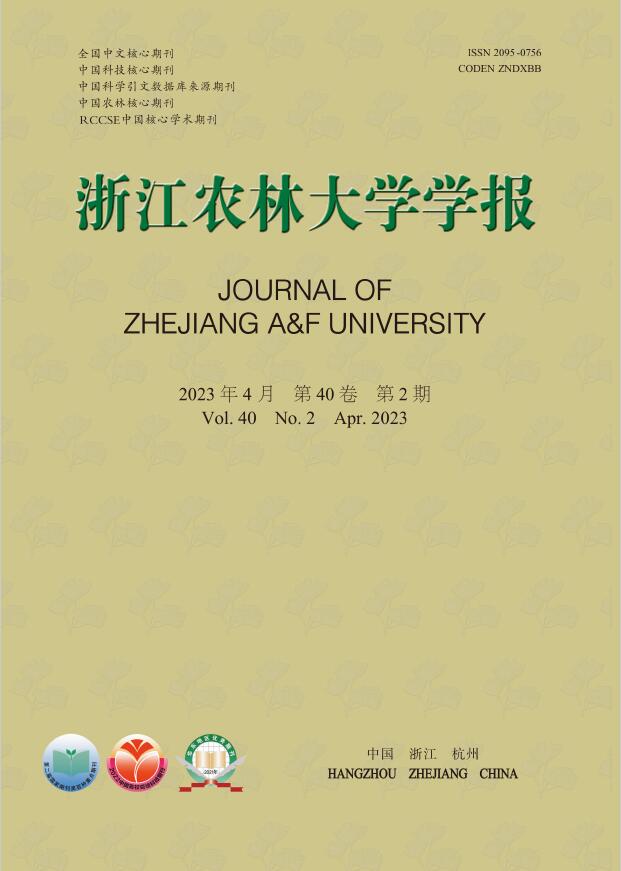






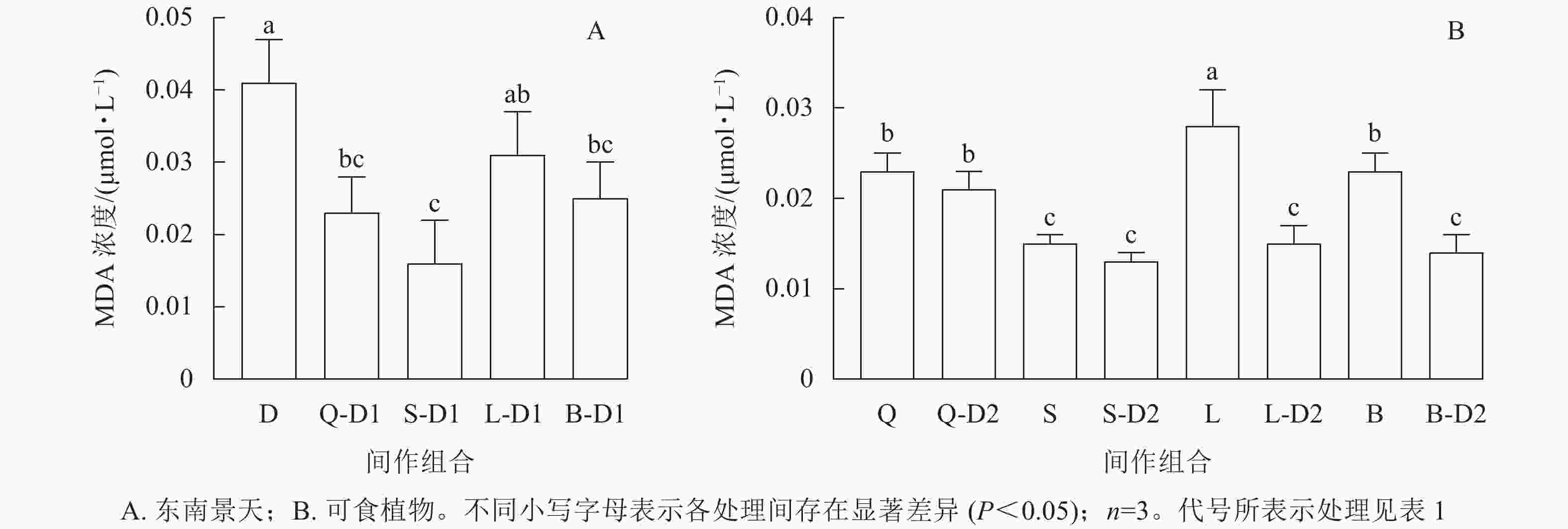
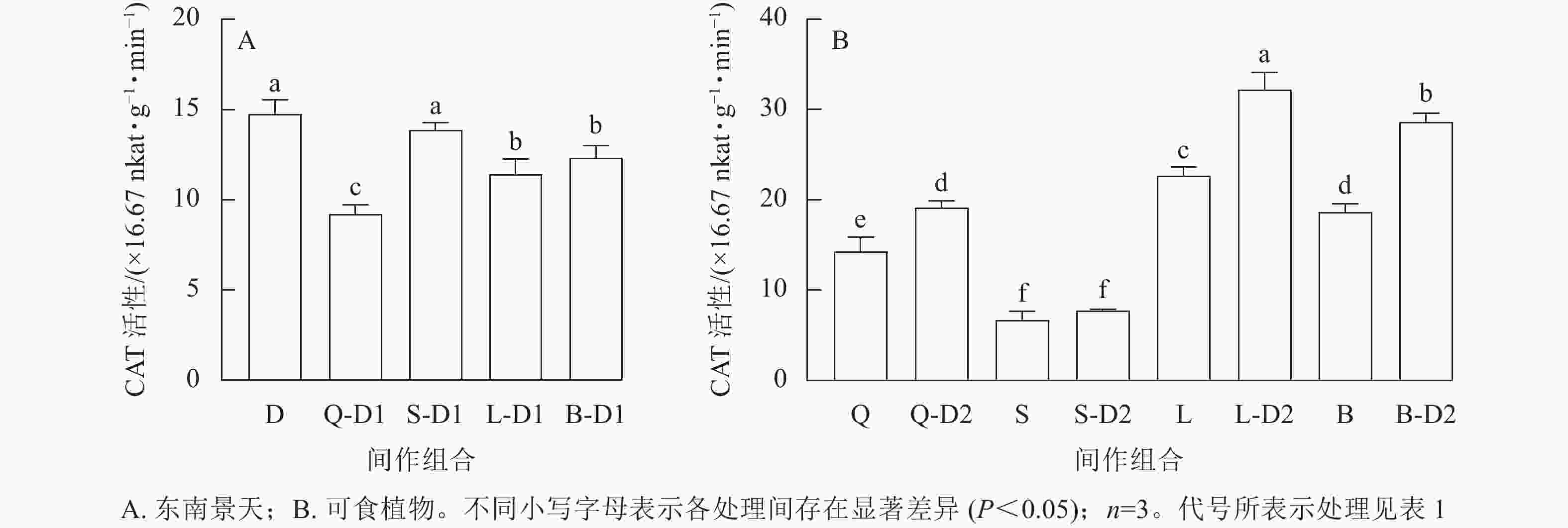


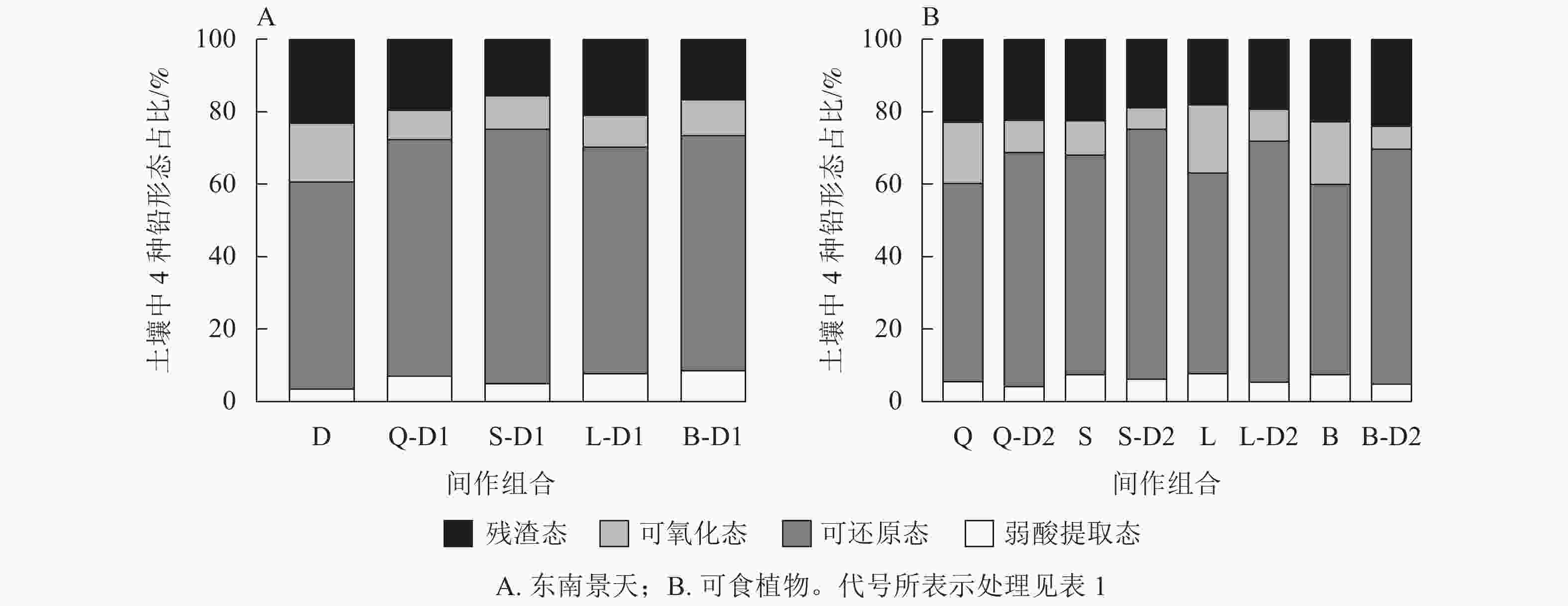
 DownLoad:
DownLoad:
